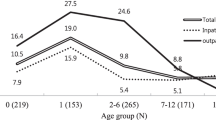Abstract
Four different laboratory tests for diagnosis ofClostridium difficile-associated diarrhea were compared to determine the optimal one for management of patients with hospital-acquired diarrhea. Stool samples from 231 patients with diarrhea were tested by the following methods: culture forClostridium difficile with subsequent determination of exotoxin production, with a toxigenicClostridium difficile positive (TCP) result considered truly positive; enzyme immunoassay (EIA); latex agglutination test; and an immunobinding blot assay. The rates of positive results were as follows: EIA 5.5%, TCP 7.3%, latex agglutination 16.7%, and immunobinding blot assay 26.1%. Compared to the TCP results, the sensitivity and specificity were, respectively, 61 and 98% for EIA, 47 and 85% for latex agglutination, and 60 and 76% for the immunobinding blot assay. Samples from patients with ≥ 6 stools/day were TCP and EIA positive in 27 and 17% of cases, respectively, whereas in patients with < 6 stools/day, these percentages decreased to 2 and 3%, respectively (p < 0.001). In hospitalized patients with ≥ 6 stools/day, EIA appears to be the optimal test for diagnosis ofClostridium difficile-associated diarrhea, with a 73% positive predictive value and a 97% negative predictive value. However, in patients with < 6 stools/day, the prevalence ofClostridium difficile is low, and laboratory detection of this organism remains problematic.
Similar content being viewed by others
References
Finney JMT: Gastroenterology for cicratizing ulcer of the pylorus. John Hopkins Hospital Bulletin 1893, 4: 53–54.
Khan MY, Hall WH: Staphylococcal enterocolitis: treatment with oral vancomycin. Annals of Internal Medicine 1966, 65: 1–8.
Altemeier WA, Hummell RP, Hill EO: Staphylococcal enterocolitis following antibiotic therapy. Annals of Surgery 1963, 157: 847–852.
Tedesco FJ, Barton RW, Alpers DH: Clindamycin-associated colitis: a prospective study. Annals of Internal Medicine 1974, 81: 429–433.
Bartlett JG, Chang TW, Gurwith M, Gorbach SL, Onderdonk AB: Antibiotic-associated pseudomembranous colitis due to toxin producing clostridia. New England Journal of Medicine 1978, 298: 531–534.
Larson HE, Price AB, Honour P, Borriello SP:Clostridium difficile and the aetiology of pseudomembranous colitis. Lancet 1978, i: 1063–1066.
Bartlett JG: Antibiotic associated diarrhea. Clinical Infectious Diseases 1992, 15: 573–581.
George WL, Rolfe RD, Finegold SM:Clostridium difficile and its cytotoxin in feces of patients with antimicrobial agent-associated diarrhoea and miscellaneous conditions. Journal of Clinical Microbiology 1982, 15: 1049–1053.
Samore MH, DeGirolam PC, Tlucko A, Lichtenberg DA, Melvin ZA, Karchmer AW:Clostridium difficile colonization and diarrhoea at a tertiary care hospital. Clinical Infectious Diseases 1994, 18: 181–187.
Mulligan ME: General epidemiology, potential reservoirs and typing procedures. In: Rolfe RD, Finegold SM (ed):Clostridium difficile — its role in intestinal disease. Academic Press, London, 1988, p. 229–256.
Pothoulakis C, Castaglinolo I, Kelly CP, LaMont JT:Clostridium difficile-associated diarrhoea and colitis: pathogenesis and therapy. International Journal of Antimicrobial Agents 1993, 3: 17–32.
Pothoulakis C, Sullivan R, Melnick DA, Triadafilopoulos G, Gardenne AS, Meshullam T, LaMonth JT:Clostridium difficile toxin A stimulates intracellular calcium release and chemotactic response in human granulocytes. Journal of Clinical Investigation 1988, 81: 1741–1745.
Triadafilopoulos G, Hallstone AE: Acute abdomen as the first presentation of pseudomembranous colitis. Gastroenterology 1991, 101: 685–691.
McFarland LV, Mulligan ME, Kwok RYY, Stamm WE: Nosocomial acquisition ofClostridium difficile infection. New England Journal of Medicine 1989, 320: 204–210.
Tabaqchaii S, Jumaa P: Diagnosis and management ofClostridium difficile infection. British Medical Journal 1995, 310: 1375–1380.
Doern GV, Coughlin RT, Wu L: Laboratory diagnosis ofClostridium difficile-associated gastrointestinal disease: comparison of a monoclonal antibody enzyme immunoassay for toxins A and B with a monoclonal antibody enzyme immunoassay for toxin A only and two cytotoxicity assays. Journal of Clinical Microbiology 1992, 30: 2042–2046.
Barbut F, Kajzer C, Planas N, Petit JC: Comparison of three enzyme immunoassays, a cytotoxicity assay, and toxigenic culture for diagnosis ofClostridium difficile-associated diarrhea. Journal of Clinical Microbiology 1993, 31: 963–967.
Peterson LR, Kelly PJ: The role of the clinical microbiology laboratory in the management ofClostridium difficile-associated diarrhea. Infectious Disease Clinics of North America 1993, 7: 277–293.
Shanholtzer CJ, Willard KE, Holter JJ, Olson MM, Gerding DN, Peterson LR: Comparison of the VIDASClostridium difficile toxin A immunoassay withClostridium difficile culture and cytotoxin and latex tests. Journal of Clinical Microbiology 1992, 30: 1837–1840.
Lyerly DM, Barroso LA, Wilkins TD: Identification of the latex test-reactive protein ofClostridium difficile as glutamate dehydrogenase. Journal of Clinical Microbiology 1991, 29: 2639–2642.
Gummerlock PH, Tang YJ, Myers FJ, Silva J Jr: Use of polymerase chain reaction for specific and direct detection ofClostridium difficile in human faeces. Reviews of Infectious Diseases 1991, 13: 1053–1060.
Mattia AR, Doern GV, Clark J, Holden J, Wu L, Ferraro MJ: Comparison of four methods in the diagnosis ofClostridium difficile disease. European Journal of Clinical Microbiology & Infectious Diseases 1993, 12: 882–886.
Bond F, Payne G, Borriello SP, Humphreys H: Usefulness of culture in the diagnosis ofClostridium difficile infection, European Journal of Clinical Microbiology & Infectious Diseases 1995, 14: 223–226.
Olson MM, Shanholtzer CJ, Lee JT Jr, Gerding DN: Ten years of prospectiveClostridium difficile-associated disease surveillance and treatment at the Minneapolis VA Medical Center, 1982–1991. Infection Control and Hospital Epidemiology 1994, 15: 371–381.
Gerding DN, Johnson S, Peterson LR, Mulligan ME, Silva J Jr:Clostridium difficile-associated diarrhea and colitis. Infection Control and Hospital Epidemiology 1995, 16: 459–477.
Author information
Authors and Affiliations
Rights and permissions
About this article
Cite this article
Jacobs, J., Rudensky, B., Dresner, J. et al. Comparison of four laboratory tests for diagnosis ofClostridium difficile-associated diarrhea. Eur. J. Clin. Microbiol. Infect. Dis. 15, 561–566 (1996). https://doi.org/10.1007/BF01709364
Issue Date:
DOI: https://doi.org/10.1007/BF01709364




